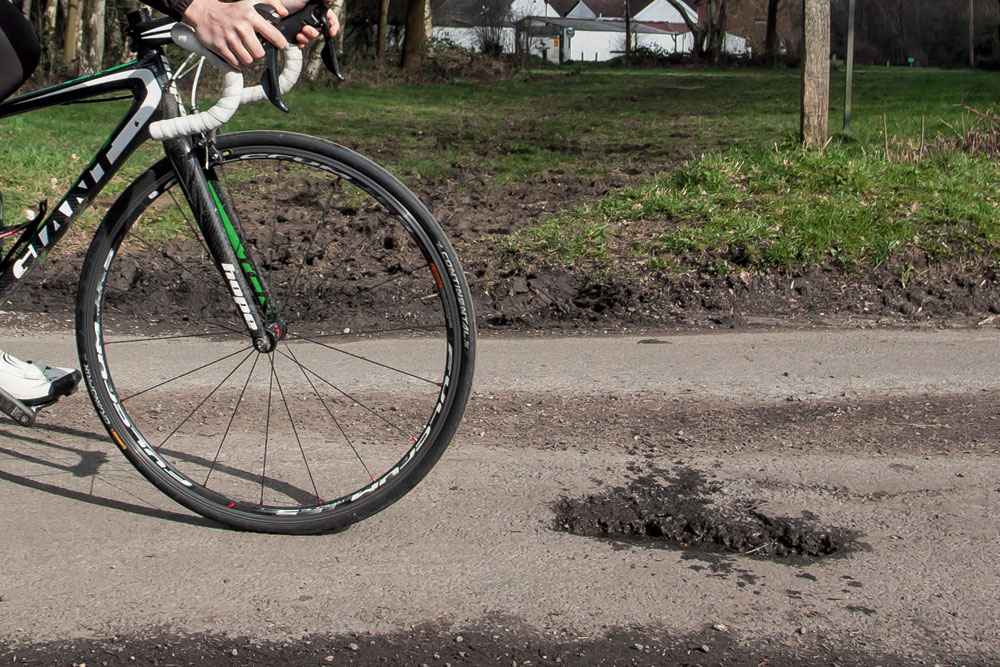Potholes: the scourge of cyclists returns for the winter
Britain's cyclists beware: a recent report suggests that Britain has over 31,000 potholes awaiting repair


Just as the onset of spring is marked by the flowering of daffodils, the arrival of winter is signified by something more sinister: a rash of potholes all over the roads. For cyclists, the rapid appearance of potholes can be a lethal problem.
According to recent figures released by insurance company Liverpool Victoria, there are more than 31,000 potholes on Britain's roads, with 12,000 miles of road awaiting repair. Councils in Britain paid out £1.6million in the 2014-15 financial year in compensation for damage caused by defective roads.
Potholes may cause damage to cars and other vehicles, but to a cyclist they can be deadly. If you try to avoid a pothole, you may be forced out into the road. If you hit it, you run the risk of being thrown off the bike as well as causing damage to your machine.
Earlier this year, the widow of cyclist Martyn Uzzell was awarded a 'six figure' compensation after Uzzell was killed after his bike hit a pothole in North Yorkshire. The 51-year-old was undertaking a charity ride from Land's End to John o' Groats in 2011 when he hit the hole and was thrown into the path of a car. He died from head injuries.

Cyclists' guide to dealing with potholes
A couple of very poor winters coupled with a shortage of repair funds means potholes are everywhere. Here’s how to
Olympic team pursuit champion Dani King sustained five broken ribs and a collapsed lung after hitting a pothole during a training ride last November.
Sadly, neither incident is an isolated one.
Get The Leadout Newsletter
The latest race content, interviews, features, reviews and expert buying guides, direct to your inbox!
Although prevention of potholes is better than cure, there is a way to report the presence of holes in the road. National cycling charity CTC created the FillThatHole website and app that lets people report the exact position of a pothole (or holes). This information is then passed on to the relevant authority for action.
A total of 546 holes were reported by FillThatHole in October 2015.
Potholes are formed in a number of ways. A small blemish in the road, for example next to an existing road repair or manhole cover, gets steadily larger as the tyres of vehicles hit it and chip away the edges.
Watch: Buyers' Guide - winter clothing
Water can cause or exacerbate holes in the road, by washing material out of a hole. When the temperature drops, any water in a hole can expand when it freezes causing the road surface to break up further and enlarging the hole.
Although it can be impossible to predict the appearance of a pothole - even on roads familiar to you - there are a few things cyclists can do to reduce the risk of incident or injury when encountered holes in the tarmac. We have put together a Cyclists’ Guide to Dealing with Potholes to help you combat this recurring menace.

Thank you for reading 20 articles this month* Join now for unlimited access
Enjoy your first month for just £1 / $1 / €1
*Read 5 free articles per month without a subscription

Join now for unlimited access
Try first month for just £1 / $1 / €1

Nigel Wynn worked as associate editor on CyclingWeekly.com, he worked almost single-handedly on the Cycling Weekly website in its early days. His passion for cycling, his writing and his creativity, as well as his hard work and dedication, were the original driving force behind the website’s success. Without him, CyclingWeekly.com would certainly not exist on the size and scale that it enjoys today. Nigel sadly passed away, following a brave battle with a cancer-related illness, in 2018. He was a highly valued colleague, and more importantly, an exceptional person to work with - his presence is sorely missed.
-
 'This is a fresh start' - Belgian rider returns to professional cycling after two year anti-doping ban
'This is a fresh start' - Belgian rider returns to professional cycling after two year anti-doping banShari Bossuyt to ride for AG Insurance-Soudal from June
By Adam Becket
-
 'This is the marriage venue, no?': how one rider ran the whole gamut of hallucinations in a single race
'This is the marriage venue, no?': how one rider ran the whole gamut of hallucinations in a single raceKabir Rachure's first RAAM was a crazy experience in more ways than one, he tells Cycling Weekly's Going Long podcast
By James Shrubsall